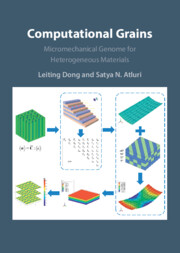Book contents
- Computational Grains
- Computational Grains
- Copyright page
- Contents
- Preface
- 1 Introduction
- 2 Computational Homogenization in the Micromechanics of Heterogeneous Materials
- 3 Direct Numerical Simulation of Materials Using Computational Grains
- 4 Trefftz Trial Functions for Computational Grains for Planar and 3D Problems
- 5 Computational Grains for Particulate Composites and Porous Materials
- 6 Computational Grains for Cylindrical Fiber Composites
- 7 Computational Grains for Nanocomposites
- 8 Computational Grains for Composites with Coated Inclusions
- 9 Computational Grains for Viscoelastic Composites
- 10 Computational Grains for Piezoelectric Composites/Porous Materials
- 11 Computational Grains with Embedded Microcracks in the Matrix and Inclusions
- 12 Multi-Scale Modeling of Composite Structures Using Computational Grains
- Index
- References
1 - Introduction
Published online by Cambridge University Press: 05 October 2023
- Computational Grains
- Computational Grains
- Copyright page
- Contents
- Preface
- 1 Introduction
- 2 Computational Homogenization in the Micromechanics of Heterogeneous Materials
- 3 Direct Numerical Simulation of Materials Using Computational Grains
- 4 Trefftz Trial Functions for Computational Grains for Planar and 3D Problems
- 5 Computational Grains for Particulate Composites and Porous Materials
- 6 Computational Grains for Cylindrical Fiber Composites
- 7 Computational Grains for Nanocomposites
- 8 Computational Grains for Composites with Coated Inclusions
- 9 Computational Grains for Viscoelastic Composites
- 10 Computational Grains for Piezoelectric Composites/Porous Materials
- 11 Computational Grains with Embedded Microcracks in the Matrix and Inclusions
- 12 Multi-Scale Modeling of Composite Structures Using Computational Grains
- Index
- References
Summary
This chapter provides a very brief summary of the types of heterogeneous materials considered in this monograph: fiber-reinforced composites, particulate composites, nanocomposites, porous composites, and so on. A succinct summary is given of analytical homogenization methods to determine the overall properties of particulate composites based on the upper and lower bounds of Hashin and Shtrikman; the Eshelby ellipsoidal inclusion theory and the Self-consistent Method of Eshelby; and the Mori-Tanaka Method and some other semi-analytical methods. Numerical methods such as the finite element method, the boundary element method, XFEM, and so on to model a representative volume element (RVE) of a heterogeneous material are reviewed, and thus the motivation for the Computational Grains method discussed in the rest of this book is presented.
Keywords
- Type
- Chapter
- Information
- Computational GrainsMicromechanical Genome for Heterogeneous Materials, pp. 1 - 16Publisher: Cambridge University PressPrint publication year: 2023

